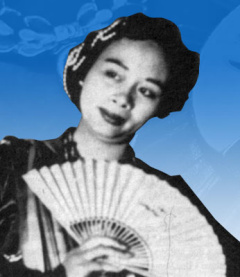
The Cultural Center of the Philippines Foundation, Inc. is a government-owned and controlled corporation established to preserve, develop and promote arts and culture in the Philippines. The CCP was established through Executive Order No. 30 s. 1966 by President Ferdinand Marcos. Although an independent institution of the Philippine government, it receives an annual subsidy and is placed under the National Commission for Culture and the Arts for purposes of policy coordination. The CCP is headed by an 11-member Board of Trustees, currently headed by Chairperson Margarita Moran-Floirendo. Its current president is Arsenio Lizaso.

Leandro Valencia Locsin, Sr., also known by the initials LVL and the nickname "Lindy", was a Filipino architect, artist, and interior designer known for his use of concrete, floating volume and simplistic design in his various projects. An avid collector, he was fond of modern painting and Chinese ceramics. He was proclaimed a National Artist of the Philippines for Architecture in 1990 by the late President Corazon C. Aquino.
Guillermo Gómez Rivera is a Spanish Filipino multilingual author, historian, educator and linguistic scholar whose lifelong work has been devoted to the advocay to preserve Spanish culture as an "important element" of the Filipino identity.

Philippine Women's University (PWU) is a coeducational tertiary education school which has its main campus in Manila, Philippines. An institution exclusive for girls from its inception until the 1970s, the PWU now admits both women and men as its students.

Singkil is an ethnic dance of the Philippines that has its origins in the Maranao people of Lake Lanao, a Mindanao Muslim ethnolinguistic group. The dance is widely recognized today as the royal dance of a prince and a princess weaving in and out of crisscrossed bamboo poles clapped in syncopated rhythm. While the man manipulates a sword and shield, the woman gracefully twirls a pair of fans. The dance takes its name from the belled accessory worn on the ankles of the Maranao princess. A kulintang and agung ensemble always accompanies the dance. Singkil has evolved over time, with significant reinterpretations and changes introduced by the Bayanihan folk dance group, such as the incorporation of the elements from the Darangen epic, particularly the episodes involving Prince Bantugan and Princess Gandingan.

Leonor Orosa Goquingco was a Filipino national artist in creative dance, who was also known for breaking tradition within dance. She played the piano, drew art, designed scenery and costumes, sculpted, acted, directed, danced and choreographed. Her pen name was Cristina Luna and she was known as Trailblazer, Mother of Philippine Theater Dance and Dean of Filipino Performing Arts Critics. She died on July 15, 2005, of cardiac arrest following a cerebro-vascular accident at the age of 87.
The arts in the Philippines reflect a range of artistic influences on the country's culture, including indigenous art. Philippine art consists of two branches: traditional and non-traditional art. Each branch is divided into categories and subcategories.
The Philippines is home to several folk dances such as Tinikling, Pandanggo, Cariñosa, and Subli. Dance has integrated itself in Philippine society over the course of many years and is imbedded in Philippine culture.
![<i>Secreto de confesión</i> (film) 1939 [[Commonwealth of the Philippines]] film](https://upload.wikimedia.org/wikipedia/commons/thumb/c/cb/Secreto_de_confesion.jpg/320px-Secreto_de_confesion.jpg)
Secreto de Confesión was the first Filipino film in the Spanish language, presented at the time as la primera película hablada y cantada en español producida en Filipinas.

Lucrecia Roces Kasilag was a Filipino composer and pianist. She is particularly known for incorporating indigenous Filipino instruments into orchestral productions.
Feliciano Dilo "Lito" Calzado was a Filipino actor, director, and choreographer.

Sarao Motors, Inc. is a Filipino automotive manufacturing company headquartered in Las Piñas, Metro Manila, the Philippines. The company specializes in designing, engineering, manufacturing, and distributing the jeepneys.

Helena Zoila Tirona Benitez was a Filipina academic and administrator of the Philippine Women's University.
Kularts is a San Francisco, California, based non-profit organization founded in 1985. It presents contemporary and tribal Filipino arts. Its mission is to expand the understanding of American Filipino culture, by sponsoring productions and presentations in the United States. Through its programs of performances, visual arts, community dialogues, and festivals, the organization hopes to advance the spirit and integrity of ancestral Filipino art and cultures.

Marielle Benitez–Javellana is a Filipino footballer who formerly played for the Philippine women's national football team. She plays in the midfield position. She is also a sports news anchor.
Filipino Americans have a long history of music in the United States. The Philippines have musical context and varied influences due to indigenous traditions and early colonial influences of Spanish and American occupation. During occupation by the United States, many Filipinos were recruited for manual labor along the West Coast. These early laborers commonly would perform Spanish-influenced rondallas as well as choral groups. With many Filipinos living in the United States beginning around the 1900s, Filipinos have contributed towards early Americana staples such as blues and jazz, and continue to influence more modern contemporary genres such as hip hop and rock. American music has also been influential in the Philippines for artists and vice versa. Though contributing to the evolution of American music, large number of Filipino Americans have a strong identity with culture of the Philippines by participating or organizing traditional dances and musical performances, largely in the form of PCNs on university campuses. Traditional dances and musical performances commonly practiced in the US are rondallas, choral groups, and gong chime ensembles. College campuses often organize performances on campuses, but can also have characteristics unique to America, as many Filipino Americans want to share their experiences of living in America and perform a more neo-traditional variation of traditional performances.
Dances produced and performed by Filipino Americans have long been a staple within the Filipino American community as an art form which has been used to educate others on culture, national identity, and community as a whole. This art form is an example of a commentary set forth by Filipino Americans and embodies many important issues, such as nationalism, orientalism, as well as the historical and modern origins of both Filipinos and Filipino Americans. From this commentary emerged the Pilipino Cultural Night or PCN as it is commonly abbreviated, in which the focus was placed on Filipino Students and their communities.

Alice Garcia Reyes is a Filipina dancer, choreographer, teacher, director and producer. The founder of Ballet Philippines, she received since June 20, 2014 from the Philippine President Benigno Aquino III the highest award in the Arts, National Artist of the Philippines. She was chiefly responsible in popularizing contemporary dance with the Alice Reyes Dance Company which staged the first modern dance concert at the Cultural Center of the Philippines Main Theater in February 1970. It was this company that later became Ballet Philippines. She is best known for "Bungkos Suite", "Carmen", "Carmina Burana", "Romeo and Juliet", "Rama Hari", "Cinderella", "Amada", "Itim-Asu", and "Tales of the Manuvu"—all nuanced with Filipino culture, gesture and grace.

Lucrecia Faustino Reyes-Urtula was a Filipino choreographer, theater director, teacher, author and researcher on ethnic dance. She was the founding director of the Bayanihan Philippine National Folk Dance Company and was named National Artist of the Philippines for dance in 1988.